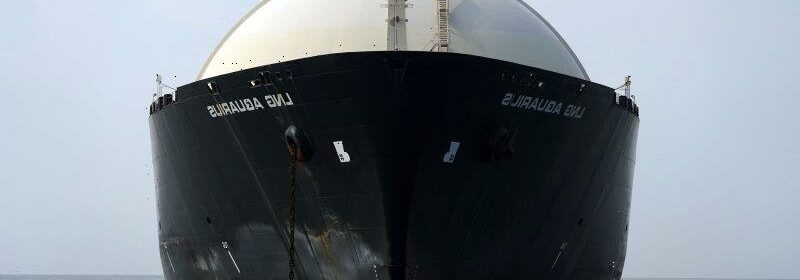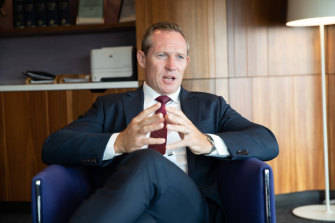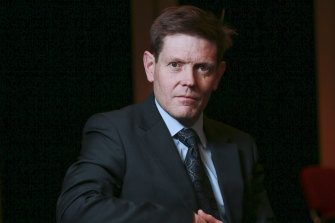Victoria demands ‘immediate measures’ to prevent gas supply crisis

Victoria is demanding “immediate measures” to stave off a looming gas supply crisis, including giving the market operator clout to control the amount of gas available at a crucial storage facility in Victoria’s south-west that is now running dangerously low.
Ahead of an August 12 meeting of state and federal energy ministers, Victorian Energy Minister Lily D’Ambrosio told The Age she wants the Australian Energy Market Operator (AEMO) to set guaranteed minimum gas storage levels at key national storage facilities such as Lochard Energy’s Iona Gas Plant, located near Port Campbell.
Lochard Energy’s Iona underground gas storage plant in Victoria is being drained to dangerously low levels owing to soaring demand.
That would act as a proxy curb on exports by forcing gas producers to store more of the resource locally rather than taking advantage of soaring world demand.
D’Ambrosio said it was “frankly unacceptable” that somewhere with as much gas as Australia could face such high prices.
“While we’ve long supported a national gas reserve, we also need immediate measures to address the pressures the national market is facing, ensuring Victorians are protected from greedy energy companies,” D’Ambrosio said.
“Our expectation is that AEMO would be able to implement this plan immediately, while federal and state governments have time to introduce a considered national energy reserve.”
Victorian Energy Minister Lily D’Ambrosio.Credit:Joe Armao
The proposal follows growing alarm about the rate at which gas is being drained from Iona, the largest independent provider of storage to the east coast gas market.
The energy market operator was this week forced to stage a dramatic intervention, including forcing Queensland suppliers to pipe more gas to NSW to free up supplies for Victorian power generation.
On Wednesday, Queensland’s Energy Minister Mick de Brenni claimed his state had been doing the heavy lifting in the national energy market.
“We’re sending 300 terajoules of gas a day to southern states, enough to power hundreds of thousands of homes,” de Brenni said.
“We are committing this supply to help Victorians and residents of NSW through one of their toughest winters on record.”
Australia’s energy market remains a mess. Professor Bruce Mountain, director of the Victoria Energy Policy Centre, said coal power generators were now “way past their prime”, and there was a lack of wind and solar power available to offset the decline in coal.
“As a consequence, gas has been forced into the market to produce a great deal more electricity than it normally does,” he said. “We have inefficient gas generation for power, its purpose is purely to meet peaks, but it’s not just meeting peaks, it’s running very frequently, so that’s draining a whole lot of gas out of the system.”
Mountain said Victoria produced more gas than it used, but the supply crisis had been exacerbated by a gas crisis in Europe and less production than expected from Queensland’s coal seam gas fields.
Queensland’s Energy Minister Mick de Brenni says his state is doing the heavy lifting in the national energy market.Credit:Attila Csaszar
He said Victoria’s plan to give the market operator powers to set minimum storage levels represented a proxy plan to curtail gas exports. He said normally such an intervention would not be warranted, but spot prices for gas had reached absurdly high levels.
“I think … actually trying to constrain export markets to some degree sounds eminently sensible,” Mountain said.
Gas producers see things differently. David Maxwell, managing director of Cooper Energy, which supplies the Victorian market from gas fields in the Gippsland and Otway basins, said demand for gas had been growing “at levels people didn’t expect”, while supply remained tight because of under-investment, with only a handful of producers in the south-east.
“That pushes prices up,” he said.
Maxwell said the big coal seam gas projects in Queensland required scale linked to international export markets to make economic sense, making it hard to separate out gas for domestic use.
“There was a bigger gas shortage looming before the development of the coal seam gas industry for LNG and Queensland,” he said. “The coal seam gas for LNG and Queensland has brought more supply into the market.”
Federal Energy Minister Chris Bowen said Australia’s energy market had been undermined by climate chaos and delay for a decade, claiming the former government had left a “gas bin fire” rather than a gas-led recovery.
He said it had been agreed to help AEMO manage peak day gas supply shortfalls by enabling it to better utilise storage, ahead of a broader package of gas market proposals.
Bruce Mountain, director of the Victoria Energy Policy Centre.Credit:Wayne Taylor
Australian Petroleum Production and Exploration Association acting chief executive Damian Dwyer said gas production was at record levels.
“Production is at record levels to serve the extraordinary gas demand during recent energy grid pressures when coal and renewable power generation faltered and gas stepped up to save the day,” Dwyer said.
On Wednesday, D’Ambrosio told the Australian Strategic Business Forum that Victoria was a net exporter of gas and the supply problem was a national issue that required long-term reform.
D’Ambrosio said she welcomed the AEMO intervention and said energy companies prioritising exports were to blame for the shortfall.
Alinta Energy chief executive Jeff Dimery said the east coast of Australia should implement a gas reservation policy similar to Western Australia in light of the recent challenges to gas supply.
He said energy policy in Australia had been “a mess” for almost the last 20 years, leading to uncertainty and the electricity and gas supply problems experienced in recent months.
“We had a view that this might happen, quite frankly,” Dimery said.
The Morning Edition newsletter is our guide to the day’s most important and interesting stories, analysis and insights. Sign up here.
Most Viewed in National
From our partners
Source: Read Full Article



